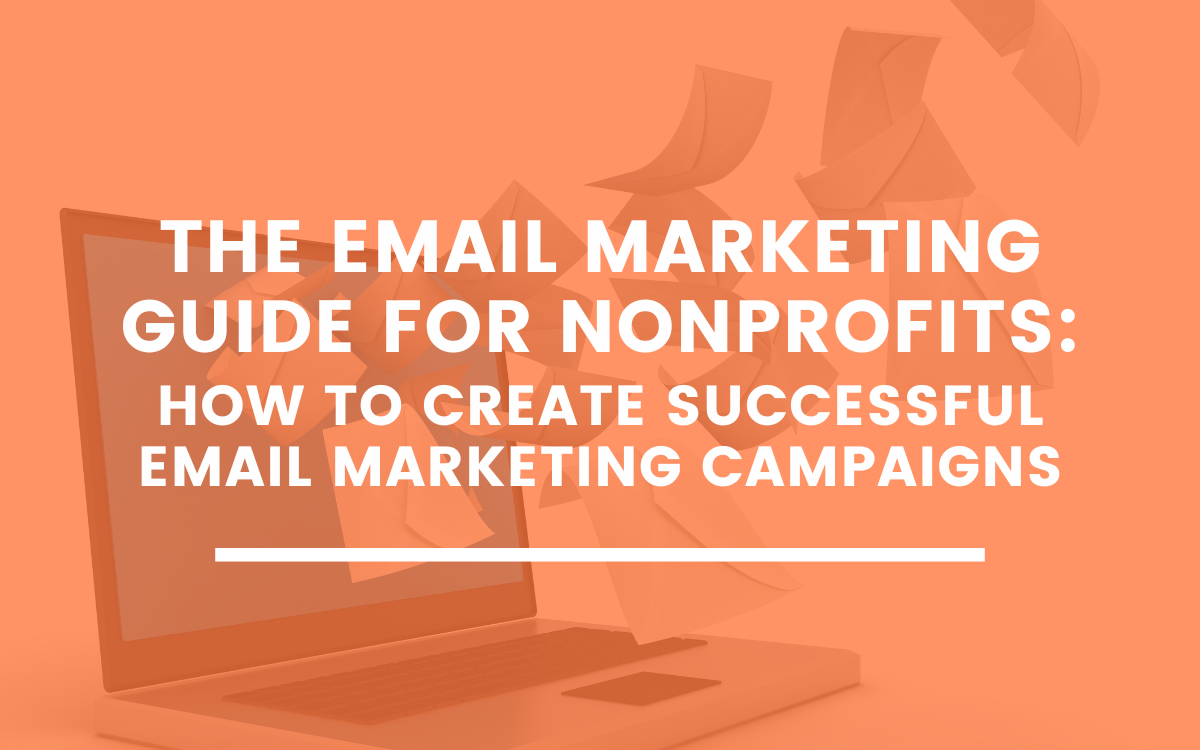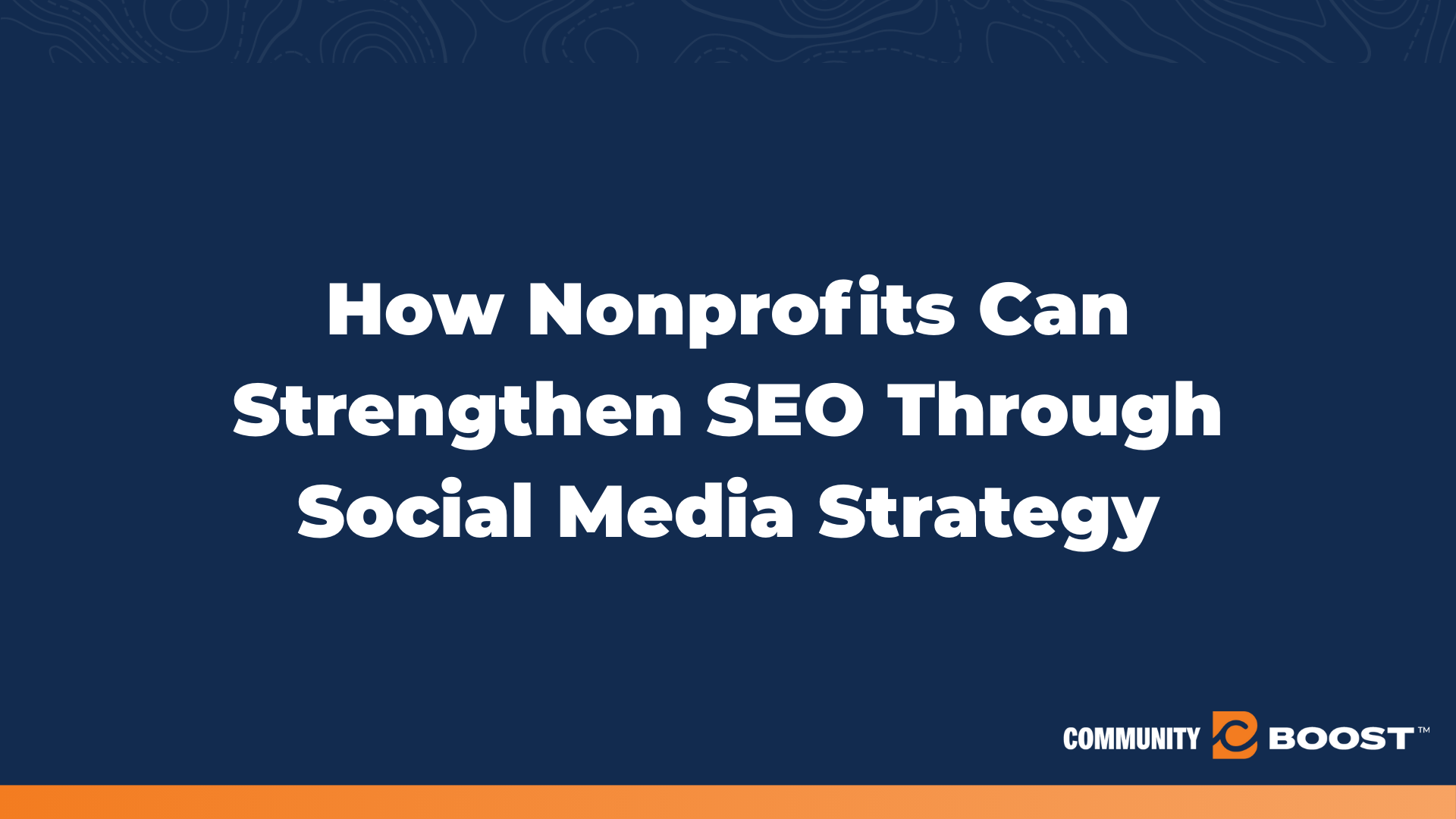The Email Marketing for Nonprofits Guide: How to Create Successful Email Marketing Campaigns for Nonprofits
10 min to read ✭ In this post, you'll learn best practices, strategies, and examples on how to set up email marketing for nonprofits, so your organization can get more funding and support!
With so many different channels to communicate with supporters, why should nonprofits use email marketing? Email marketing has been proven to be one of the most important tools a nonprofit marketer could use. There is no better way to effectively reach prospective donors and other key audiences on a limited budget, and in a highly personalized manner than to do it via email.
In this post, we’ll be covering why email marketing is so important, how to grow your email subscriber list, how to segment your email list, and how to make the most out of every email you send.
What Is Email Marketing?
Email marketing is a powerful tool that allows nonprofits to engage with their audience of donors, volunteers, and supporters with tailored and specific messaging.
How Can Email Marketing Be Utilized By Nonprofit Organizations?
Email makes it easy to communicate with your audience about upcoming events and fundraising efforts. It can also be used to demonstrate impact, show gratitude, offer volunteer opportunities, and spread general awareness about your cause. It takes minimal effort to put an email together and ultimately will help your organization develop a loyal donor base, expand your reach, and drive more donations.
1. Email Marketing For Nonprofits Organizations Is Relatively Inexpensive
We get it, budget concerns are real. Luckily, email marketing software is affordable and known for delivering the highest return on investment. According to the M+R Benchmarks, for every 1,000 fundraising emails sent, you’ll raise an average of $45. Additionally, some email marketing software providers will offer free or discounted services to nonprofits.
2. Email Marketing Allows Nonprofits To Reach Donors And Volunteers Directly
If you just held an event, and you want to say thank you to attendees, you can send a personalized email straight to their inbox as a thank you. Even with a growing supporter base, email allows you to communicate with more people without losing that personal touch. This makes email much more personal than other channels, like social media.
3. Email Marketing Helps Nonprofits Share Their Stories
You’ve established a direct line of communication with people that are willingly expressing interest in your cause, which means they would love to hear your stories of impact! Sharing your stories via email helps you stay top-of-mind so when it’s time to ask for a donation, your list is excited to offer a gift.
4. Email Marketing Saves Time
Here’s the secret beauty of email for nonprofits: you can automate email campaigns while still exhibiting an authentic connection with your audience. Forget the days of chain mail. The classic mass email has now been upgraded all thanks to email features like merge-tagging fields and sequences that can be created. You can save time without compromising quality.
5. Nonprofits Can Generate One-Click Conversions With Email Marketing
With a proper email marketing campaign, the calls to action incorporated within your email send will actually get people to click and convert from within your email. While this goes back to providing value, a benefit of email marketing is certainly how easy it is for your recipient to receive, read, and take action.
The Dos And Dont’s Of Email Lists
Asking for donations and support can be tricky via email due to the fact that it’s not quite as personal as face-to-face interactions. If the email copy doesn’t resonate with your audience, the email could be completely ignored or moved to the trash. Luckily, we here at Community Boost have assembled a handy little list of key Do’s and Don’ts when it comes to dealing with this sticky subject. Check it out!
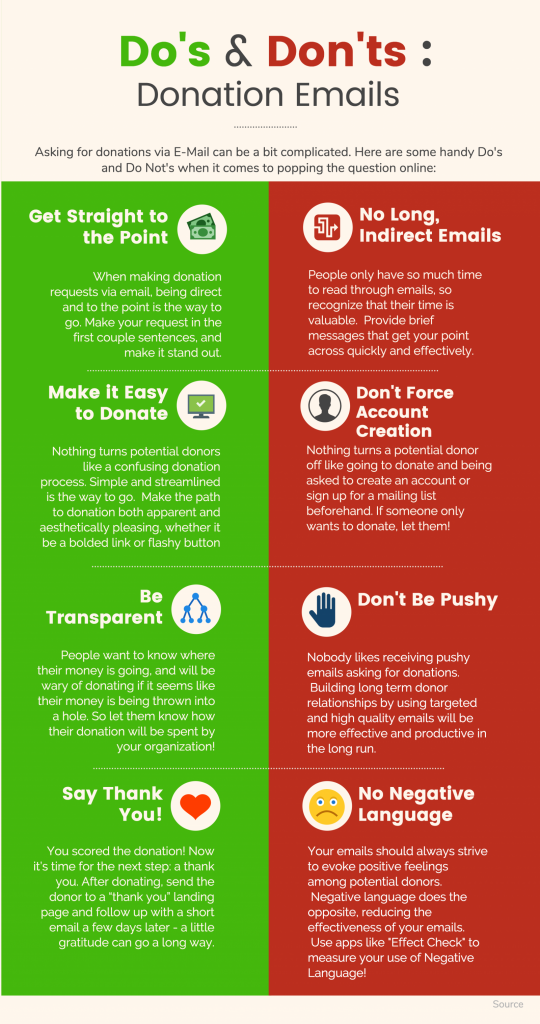
How To Start Growing Your Email List
It’s important to have strategies in place that will continually grow your email list. Once they are in place, it will take little work to maintain them. One thing to keep in mind is that growing your email list just for the sake of having more subscribers isn’t always best. It’s better to have an email list of people that are actually interested in supporting your cause. Think quality over quantity, otherwise your email engagement will be low, and mail will often end up in the trash.
1. Reach Out To Past Donors Or Volunteers
If someone has donated or volunteered with your organization in the past, chances are they would be a great fit for joining your email list. Reach out to these people with a gentle ask to subscribe to your mailing list, and let them know what kind of emails they can expect to receive.
2. Add A Subscription Box On Your Website
Oftentimes, if someone is viewing your website and they’re interested in supporting your cause they will be willing to subscribe to your mailing list. Make this as easy as possible by having a sign-up form on your homepage or even create a pop-up for when a user has been on your website for a few minutes.
3. Post About It On Your Social Media Posts
Encourage your followers to subscribe to your emailing list by posting on social media. For example, share a story of impact and include a call to action in your caption to read or see more by subscribing to your mailing list.
4. Allow Supporters To Sign Up When Completing A Donation
If someone has made a commitment to your organization, it’s safe to say they are interested in your cause! Capitalize on this low-hanging fruit by adding an email list opt-in when they provide their contact information while registering for an event, signing a petition, or donating.
5. Ask In Person
Ask for signups while at in-person networking or volunteering events. This old-school method definitely works, so come prepared with a sign-up sheet or a tablet for people to fill in their information.
How Segmenting Your Email List Leads To More Donations
Segmenting is an incredibly useful strategy, as it allows you to pinpoint exactly what you want to say to an exact audience, so it allows the audience to feel tailored to! People are more likely to engage with content that is relevant to them, which is why tailoring your messaging is so important. You also do not want to overwhelm your audience with emails so segmenting can ensure they only receive the ones that apply to them.
Deep Dive into Donor Segmentation
Before we categorize our donors, let’s take a moment to consider the layers of segmentation that can significantly enhance our approach:
Behavioral Segmentation
This involves dividing your audience based on their interactions with your organization. This could include their past donation behavior, their engagement with previous email campaigns (such as which emails they opened and what links they clicked), or their participation in events. This type of segmentation helps in sending targeted content that is relevant to the activities they’ve shown interest in or interacted with.
Engagement Level Segmentation
This strategy segments the audience based on how active or inactive they are in your communications or activities. For example, you might segment active subscribers who regularly open emails and interact with content differently from those who rarely open emails. This allows you to tailor your approach to re-engage dormant subscribers or to further activate engaged ones.
Donation Size Segmentation
Donors can be segmented according to the amount they donate. This allows personalized communication that acknowledges the level of their financial support. For instance, major donors might receive more personalized attention through updates on how their substantial contributions are making an impact, whereas smaller donors might receive communications designed to encourage them to become more involved or increase their contributions.
New Donor Welcome Series
This refers to a specific type of campaign targeted at first-time donors. The series typically includes several emails that thank the new donors, inform them about the nonprofit’s work and impact, and gradually engage them to deepen their relationship with the organization.
With these segmentation strategies in mind, let’s explore how they can be applied to specific groups within our donor base.
Segmenting Your Email List For Maximum Success
Let’s talk about segmenting your email list. Organizing your organization’s email list will help you better target each audience, as you can adjust your message to be as relevant as possible when you are sending emails to a group of people with similar qualities. Think about what attributes occur that spark people to give. When you dig deeper, you will pull out trends of segmentation that might help you to better organize your lists.
Here are some different categories you can segment your email list by:
1. Renewed Donors
One way to think about your segmentation is to look at renewed donors. Since these donors have made a gift in the past and renewed their gift in the current year, your email strategy should typically be around upgrading their gift or potentially moving into a recurring donor program.
Focus on content that thanks them for their continued support and clearly shows the impact of their donations. Include updates on projects they have funded and testimonials or stories from beneficiaries. This type of content reinforces the value of their contributions and can encourage them to contribute again.
2. Current Donors
Your organization’s current donors are the people who have made a gift last year but haven’t given one this year yet. If you segment that list, you will want to send them emails making a request that they donate about 50% higher than their previous donation. You can also send them emails to join a recurring giving program, which can be high in value if they decide to do so. Since they have donated in the past, they might be more open to joining a recurring donation program with your nonprofit.
To effectively re-engage these previous donors, craft emails that detail the specific progress made possible by their last contributions. Include compelling visuals or stories that show the tangible outcomes of their donations. Suggest higher contribution tiers with a clear explanation of how these additional funds will be used, and the specific benefits or recognition they will receive. Highlight the ease and impact of switching to a recurring donation model, perhaps through a special feature on what recurring support has achieved over the past year.
3. Event Donors
The event donors are people who have attended an event or even donated for the event but who haven’t really given to your organization outside of an event. These types of donors don’t really give online, so making an ask for a flat amount like $25 or $40, or however much that you think makes sense, is a good strategy to follow.
Create emails that recap the events they attended, highlighting memorable moments and the outcomes achieved thanks to their contributions. Include vibrant photos or videos from the event and testimonials from participants or beneficiaries. Offer them exclusive early access to future events as a way to maintain their interest and engagement. Consider also including a special feature story in your emails that details how event contributions have been used in the ongoing efforts of your organization. This approach helps maintain a connection with the event and may encourage more consistent giving.
4. Peer-To-Peer Donors
If your organization is running a lot of peer-to-peer fundraising, then that means that your peer-to-peer donors have not necessarily given to your organization. Maybe they have donated to a specific person that your nonprofit is supporting, but not to you directly. With that, you can merge tag your list and acknowledge the original gift.
From there, you could be sending donors an email about what their money has gone to. People like to know the direct impact they are making. Once you have warmed up your peer-to-peer donors, you can follow up by making another request. This time around, your request can be geared more towards your organization as a whole instead of one person.
5. Large Gift or Major Donors
Whatever the threshold is for your organization when it comes to your major donors, you want to treat them differently. The language surrounding your communication with your large gift donors is certainly going to be different than your other donors, right?
If your major donors are getting emails about smaller gifts, then you are leaving a lot of money on the table, as well as not acknowledging people who are giving a lot to your organization. Approaching your major donors differently makes a lot of sense, so for this reason, it’s really important to be segmenting your donor email lists.
6. Non-Donors
Finally, the last type of donor to segment your lists around is going to be the non-donors. Your email marketing strategy surrounding your non-donors should be heavily focused on going after the first gift. Acknowledge what their first gift can do and what it would mean to your organization. Hopefully, you can convert some of those people on your general email list to donors.
Enhancing Engagement Through Storytelling
By consistently embedding meaningful stories into your communications, you can transform standard updates into engaging narratives that resonate emotionally, encourage sustained engagement, and inspire further action. Storytelling not only helps to contextualize the impact of donations but also connects donors personally to the outcomes of their generosity, reinforcing their crucial role in your mission’s success.
Nonprofit Email Marketing Best Practices
By now, you know that email marketing is an incredible tool that nonprofits can use to engage with their supporters and to continuously stay top of mind. We have proven with data that email marketing is successful at increasing donations and overall site traffic. Here are twelve tips and strategy ideas to keep in mind when leveraging email marketing.
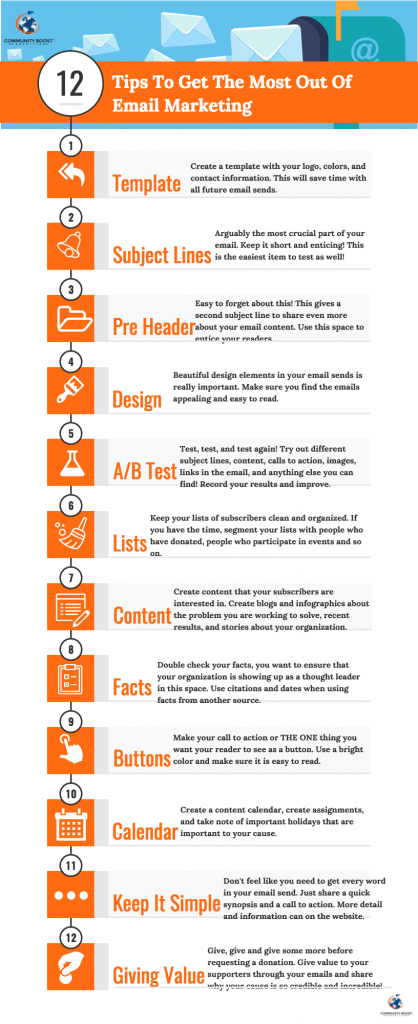
Best Practices for Email Design
To maximize the impact of your email campaigns, it’s essential to focus on both the aesthetics and functionality of your email designs:
- Responsive Design: Ensure your designs are responsive, automatically adjusting to the viewer’s screen size, whether on mobile, tablet, or desktop.
- Visual Hierarchy: Use a clear visual hierarchy to guide the reader through your content effectively, employing larger fonts for headings and smaller fonts for body text.
- Consistent Branding: Incorporate consistent branding elements like your logo and color scheme to make emails instantly recognizable.
- Clear Navigation: Keep navigation simple with easily clickable call-to-action buttons and well-spaced links to enhance user experience.
- Minimalist Design: Opt for a clean and uncluttered layout, using white space strategically to focus attention on key messages.
- Accessibility: Ensure your emails are accessible with alt text for images and appropriate text contrast.
- Device and Client Testing: Regularly test your email designs across different devices and email clients to ensure they display correctly.
Integrating these design practices will help ensure that your emails are not only visually appealing but also highly functional, encouraging greater engagement and action from your audience.
Examples Of Good (And Not So Good) Email Design
The layout, format, and copy of your email can make or break how the viewer engages with it. You should strive to create emails that are easy to read, are not too long, have high-quality images, and are very simple to understand after a 10-second glance.
A Great Email

This is an example of a thank you email that was sent by charity:water to someone who donated to them. As you can see, the email contains compelling imagery of the person who is receiving the gift, it goes into detail about how the gift will be helping this person and clearly demonstrates the direct impact the gift has. It does all these things while still being concise, and utilizes easy-to-understand visuals.
Donors who receive this email will likely feel like they’ve made a difference, like they are now a part of something bigger than themselves, and they may even be more inclined to donate again when asked because they’ve seen where their money is going.
An Email To Learn From
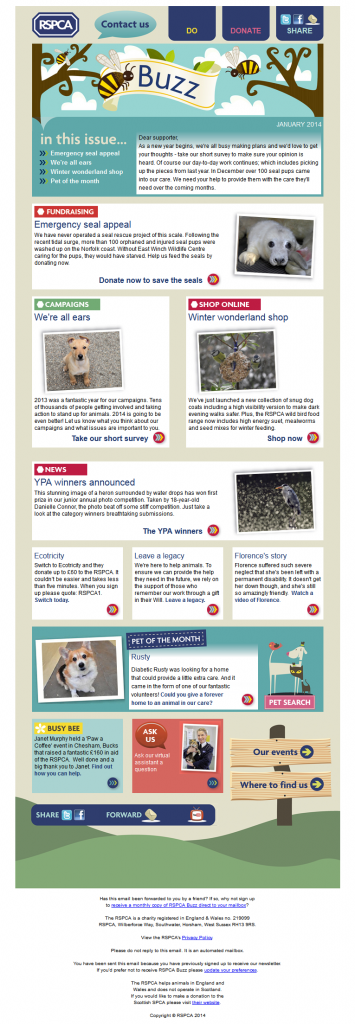
This is an example of a newsletter-style email campaign. While it does include relevant information, and titles are outlined in bold, there are some things that could be done better. For newsletters with lots of different information, try using a table of contents with quick links to help the user find the content they’re most interested in. Another suggestion would be to break up this content and be more specific to tailor it to a certain list. Lastly, try keeping the visual layout concise and not too busy.
5 Strategies To Ensure Success Within One Month Of Email Marketing
You read that right- one month! Improving your email marketing can seem like a chore, but if you can find the time to implement these proven successful strategies, you’ll see results in 30 days. Here are our top 5 tips to improve your email marketing.
1. A/B Test Your Current Email Templates
An A/B test can be extremely beneficial to your email marketing strategy. If you aren’t as familiar with it, A/B tests refer to testing two versions of the same thing, hence, test A and test B. You can A/B test with virtually anything: ads, ad copy, content creative, and even emails and newsletters. To A/B test your email marketing campaign, simply take one email, make two versions of it with slightly different elements, and send it to two different parts of your audience. This way, you can understand what performs better for your nonprofit and its audience. To learn more about how to A/B test your email campaigns, head to our blog post.
2. Segment Your List For Better Targeting
Segment your email lists based on certain tendencies, behaviors, or even traits that they may have. By grouping your list, you can offer a more personalized ask for year-end donations. It’s an important approach to make sure the people who’ve signed up to receive your emails don’t feel like your message does not resonate with them.
Taking the time to carefully organize your lists now will prove to be more effective for your nonprofit’s email marketing strategy down the line. Naturally, we are drawn towards messages that are catered to us. So, send out multiple email variations that resonate with more specific audiences instead of putting out one massive email in hopes of resonating with them all.
3. Automate A Welcome Series For New Subscribers
A welcome series is your organization’s first impression to new subscribers. It’s the initial correspondence between your nonprofit and the people whose attention you direly need. And they want to hear what you have to say! So, it’s important to warm them up to support you in the future by sending out an automated, but well thought out, welcome series. Greet them with focused, value-driven content that educates them on the purpose of your organization.
Learn more about email marketing automation in this video!
4. Give Variety And Show Value
Approach your relationship with your subscribers the same way you build your relationships with your closest friends. You contribute a lot to your best friend’s life. You are always there for that person, and you probably check in with one another often. So, when you need them for something, they’re happy to do favors and contribute back to you. Friendship is a two-way street where your give and take is distributed evenly. Don’t be that friend who only takes!
Give value back to the people who are contributing to your nonprofit, sharing your cause, and supporting your organization. What stories have you accumulated that would brighten people’s day? How can you make them feel a certain emotion? How can you give your subscribers some kind of utility? These are the questions you need to be asking when you are strategizing your email marketing campaign.
5. Build Strong Email Lists With Engaging Website Design
While these email marketing tactics are valuable, they will be ineffective if you don’t have a relevant, engaged, and active email list. The foundation of a strong email marketing campaign starts from having subscribers who genuinely want to be in the loop. Appeal to engaged subscribers with compelling website design and encouraging, not annoying, onsite email opt-ins. You want the aesthetic of your email opt-in to look welcoming, not boring or flat. That being said, you do not want to build spammy pop-ups either. The important details within conversion design are how you will retain subscribers from your website visitors.
Check out our case study with the Center For Children And Youth to see how conversion design helped them scale their impact!
Optimizing Email Campaigns: Key Technical Considerations
Ensuring your emails reach and engage your audience involves understanding some key technical aspects:
Deliverability
- Maintain a good sender reputation by cleaning your list regularly and using authentication protocols like SPF, DKIM, and DMARC.
- Consider a dedicated IP if sending volumes are high to better manage your reputation.
Analytics
- Monitor metrics such as open rates, click rates, and bounce rates to gauge campaign success.
- Set up feedback loops with email providers to learn when your emails are marked as spam.
Mobile Optimization
- Ensure emails are responsive and test across different devices and email clients for consistency.
These streamlined practices will help enhance your email campaigns’ effectiveness, ensuring better reach and engagement.
How Community Boost Helped The Tenement Museum Generate $40,000 Via Email Marketing
The Tenement Museum tells the uniquely American stories of immigrants, migrants, and refugees in the ongoing creation of our nation. They came to Community Boost with the goal of keeping the museum alive- they needed to generate more donations.
Our strategy was to drive support and connect with their core audience through an email campaign appeal. The campaign highlighted the need to support the Museum at this critical time and included a way for their audience to share why they are supporting the museum to their own network.
Through this strategy, Tenement Museum saw a drastic increase in donations. In just 24 hours, we had generated $40,000+ from the email appeal which cost us absolutely nothing.
You’re Ready To Send Some Emails!
In conclusion, email marketing is a very powerful, efficient, affordable, and valuable tool for nonprofit organizations. It is one of the best ways to build a loyal donor base, generate donations, build community, and connect with your supporters.
By segmenting your audience into different lists and catering your messaging to resonate with different groups, you can maximize the opportunity to receive support, donations, and volunteers.
Sharing stories of impact, saying thank you, and providing value are all great things to include in your email campaigns, especially if you’ve put the time and effort into building a top-notch list of subscribers.


